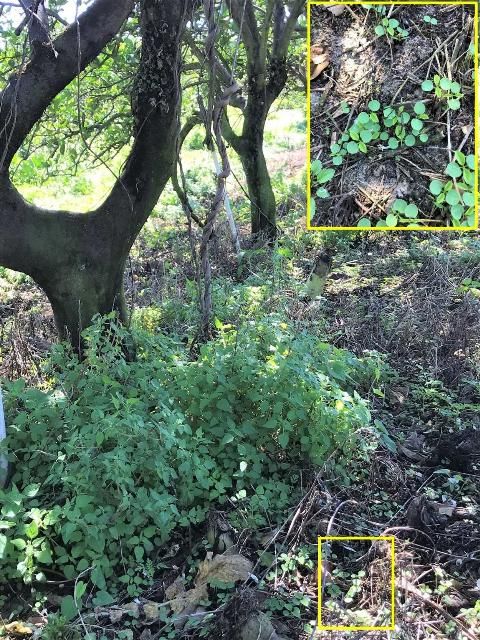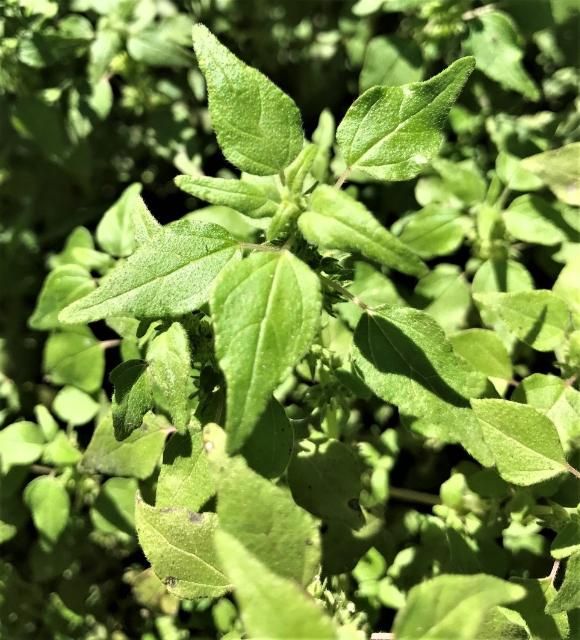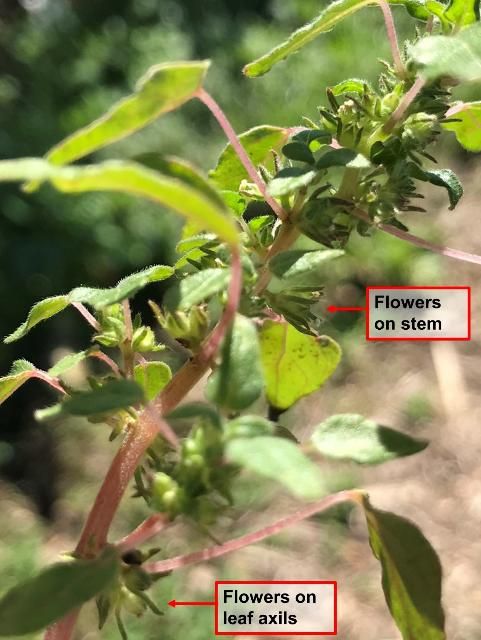Introduction
Clustered pellitory (Parietaria praetermissa), also known as white pellitory, is a trailing herb considered a common weed in disturbed areas and cropping systems (Boufford 1993). A member of the Urticaceae (nettle) plant family, it is native to the southeastern United States, from Louisiana to Florida and as far north as South Carolina (USDA NRCS 2019). In Florida, it is found on the peninsula and central panhandle in moist hammocks, floodplain forests, and disturbed sites (Wunderlin et al. 2018). Currently, it is becoming a problematic weed in citrus groves (Figure 1). Clustered pellitory thrives well in wet areas and under shade, and hence, if not controlled, it will spread quickly under citrus trees in the drip line areas.

Credit: Ramdas Kanissery, UF/IFAS
Description
Plant Height
Usually about 8 inches; can grow up to 22 inches tall.
Stem and Roots
Stems are prostrate to erect, green or pink in color, simple or freely branched at the base, and generally covered with dense and short soft hair (pubescent). Roots are fibrous and usually do not grow more than 3 inches deep.
Leaves
Thin pale green leaves are deltoid to broadly ovate, 0.15–2 inches long, 0.15–1 inch wide, and widest from the base to the middle. The upper surface of leaves typically has sparse fine hairs. The leaf has smooth margins, often with a line of hairs, and an elongated tip and leaf stalk (petiole) nearly as long as the leaf blade (Figure 2).

Credit: Ramdas Kanissery, UF/IFAS
Flowers
Tiny green flowers are clustered in the axils of the leaves (Figure 3).

Credit: Ramdas Kanissery, UF/IFAS
Life Cycle
Annual; typically emerges during winter and flowers during winter to early summer periods.
Similar Species
Clustered pellitory is very similar to Florida pellitory (Parietaria floridana). In fact, Parietaria praetermissa is frequently misidentified as P. floridana. The very long tip of clustered pellitory leaves distinguishes it from Florida pellitory, which has a short, pointed leaf tip.
Economic and Environmental Impacts
Clustered pellitory is becoming a significant weed in citrus, especially from the winter through early summer. Moisture from low-volume irrigation systems and shade provided by the tree canopy creates a conducive environment for the emergence and proliferation of this weed (Figure 1). Production of a large amount of tiny seeds allows its rapid infestation, often carpeting the tree rows. A heavy outbreak of clustered pellitory in tree rows can interrupt the spray pattern of low-volume drip irrigation systems. Clustered pellitory is a mild skin irritant when plant hairs cling to clothing, and the pollen, produced copiously in spring, may cause allergic reactions.
Management
Cultural and Physical Control
Clustered pellitory reproduces primarily through seeds, which are easily dispersed by wind because of their minuscule size. Seeds are also dispersed through machinery and vehicles. Hence, management efforts should focus on prevention and sanitation. Managing this weed prior to seed development can significantly reduce its widespread distribution in the grove. Periodic mowing, hand weeding, and mulching can help control these weeds. However, care should be taken that operations like mowing or spraying do not result in further spread of seeds.
Chemical Control
Post-emergent management can be achieved through most nonselective herbicides (e.g., paraquat, glyphosate, etc.) or broadleaf herbicides (Marble 2017). However, these herbicides are most effective when weeds are young and actively growing. Addition of a surfactant and thorough spray coverage are required for effective control of emerged weeds. Also, the application must be made before flowering to prevent the accumulation of seeds in the soil. In an unpublished study conducted at the Southwest Florida Research and Education Center in Immokalee, the pre-emergent herbicides Indaziflam (Trade name: Alion, 3 to 5 oz per acre) and flumioxazin (Trade name: Chateau, 6 to 8 oz per acre) were also found to effectively suppress the emergence of clustered pellitory when applied as a tank-mix combination.
For more information on the recommended rates of herbicides labeled for use in citrus, please see the Florida Citrus Production Guide, Chapter 44: Weeds (https://edis.ifas.ufl.edu/cg013) and Chapter 45: Pesticides Registered for Use on Florida Citrus (https://edis.ifas.ufl.edu/pdffiles/CG/CG01700.pdf).
Also, refer to EDIS article HS-1007, Maximizing Weed Control in Florida Citrus (https://ufdc.ufl.edu/IR00008663/00001), for more information on weed control in Florida citrus.
References
Boufford, D. E. 1993. "Parietaria praetermissa." In: Flora of North America. http://beta.floranorthamerica.org/Parietaria_praetermissa
Marble, C. 2017. "Central Florida Landscapes ENEWS." June 2017.
USDA NRCS. 2019. "The PLANTS Database." http://plants.usda.gov
Wunderlin, R. P., B. F. Hansen, A. R. Franck, and F. B. Essig. 2018. "Atlas of Florida Plants." http://florida.plantatlas.usf.edu/